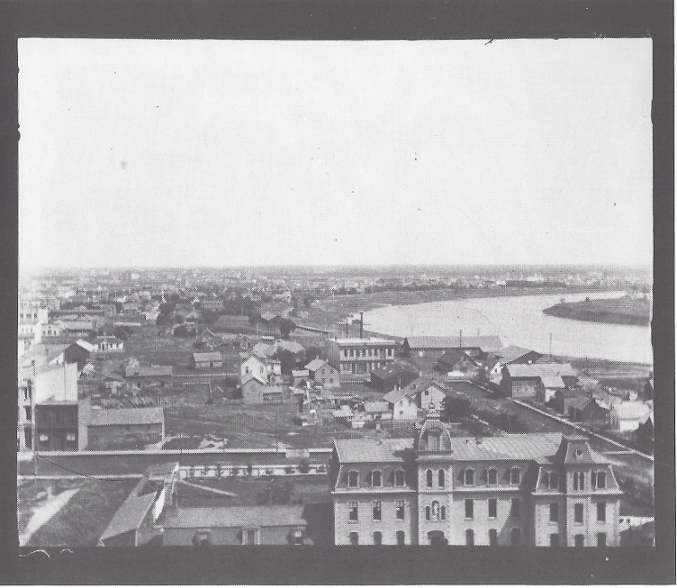Winnipeg lies at the confluence of the Assiniboine and the Red River of the North, a location now known as "The Forks". This point was at the crossroads of canoe routes travelled by First Nations before European contact. Winnipeg is named after nearby Lake Winnipeg; the name is a transcription of the Western Cree words for muddy or brackish water. Evidence provided by archaeology, petroglyphs, rock art and oral history indicates that native peoples used the area in prehistoric times for camping, harvesting, hunting, tool making, fishing, trading and, farther north, for agriculture. Estimates of the date of first settlement in this area are varied and range from 11,500 years ago for a site southwest of the present city to 6,000 years ago at The Forks.
In 1805, Canadian colonists observed First Nations peoples engaged in farming activity along the Red River. The practice quickly expanded, driven by the demand by traders for provisions. The rivers provided an extensive transportation network linking northern First Peoples with those to the south along the Missouri and Mississippi rivers. The Ojibwe made some of the first maps on birch bark, which helped fur traders navigate the waterways of the area.
Sieur de La Vérendrye built the first fur trading post on the site in 1738, called Fort Rouge. French trading continued at this site for several decades before the arrival of the British Hudson's Bay Company after France ceded the territory following its defeat in the Seven Years' War. Many French and later British men who were trappers married First Nations women; their mixed-race children hunted, traded, and lived in the area. They gradually developed as an ethnicity known as the Métis because of sharing a traditional culture.
Lord Selkirk was involved with the first permanent settlement (known as the Red River Colony), the purchase of land from the Hudson's Bay Company, and a survey of river lots in the early 19th century. The North West Company built Fort Gibraltar in 1809, and the Hudson's Bay Company built Fort Douglas in 1812, both in the area of present-day Winnipeg. The two companies competed fiercely over trade. The Métis and Lord Selkirk's settlers fought at the Battle of Seven Oaks in 1816. In 1821, the Hudson's Bay and North West Companies merged, ending their long-standing rivalry. Fort Gibraltar was renamed Fort Garry in 1822 and became the leading post in the region for the Hudson's Bay Company. The fort was destroyed by a flood in 1826 and was not rebuilt until 1835. A rebuilt section of the fort, consisting of the front gate and a section of the wall, can be found near the modern-day corner of Main Street and Broadway Avenue in downtown Winnipeg.
In 1869–70, present-day Winnipeg was the site of the Red River Rebellion, a conflict between the local provisional government of Métis, led by Louis Riel, and newcomers from eastern Canada. General Garnet Wolseley was sent to put down the uprising. The Manitoba Act of 1870 made Manitoba the fifth province of the three-year-old Canadian Confederation. On 8 November 1873, Winnipeg was incorporated as a city, with the Selkirk settlement as its nucleus. Métis legislator and interpreter James McKay named the city.
Winnipeg developed rapidly after the coming of the Canadian Pacific Railway in 1881. The railway divided the North End, which housed mainly Eastern Europeans, from the richer Anglo-Saxon southern part of the city. It also contributed to a demographic shift beginning shortly after Confederation that saw the francophone population decrease from a majority to a small minority group. This shift resulted in Premier Thomas Greenway controversially ending legislative bilingualism and removing funding for French Catholic Schools in 1890.
By 1911, Winnipeg was Canada's third-largest city. However, the city faced financial difficulty when the Panama Canal opened in 1914. The canal reduced reliance on Canada's rail system for international trade; the increase in shipping traffic helped Vancouver to surpass Winnipeg in both prosperity and population by the end of World War I.
https://en.wikipedia.org/wiki/Winnipeg

View(s) of Winnipeg from the roof of the Hotel Manitoba, July 26
Clara, Mrs. Pond and Olivia with young English gentlemen, Winnepeg, Manitoba. July 27
Mark Twain Archive, Elmira College courtesy of Kevin Mac Donnell, Austin, Texas.
